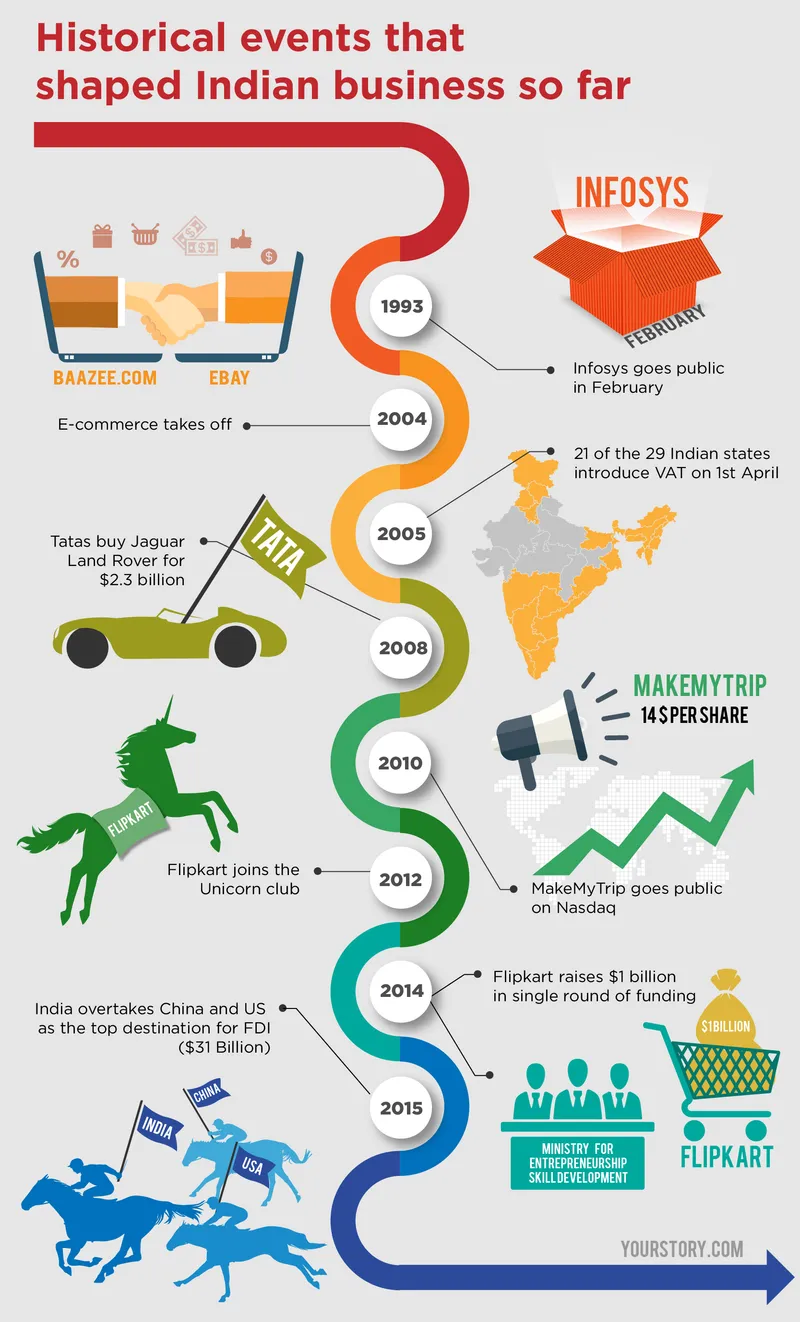History shows India’s economic growth curve at an inflection point
The Startup India, Standup India initiative has scripted a new chapter in the history of Indian business, with Prime Minister Narendra Modi announcing several crucial initiatives to boost the startup ecosystem in India. Registration of a startup in one day, 80 per cent rebate on filing of patent applications by startups, tax exemption for the first three years are some of the major announcements. The date 16th January 2016 will be remembered as one of the historical dates by the startup fraternity.

We take a look at the major business events that shaped India since liberalisation:
1991: Economic liberalisation in India through reforms that did away with much of the Licence Raj, reduced tariffs and interest rates, ended many public sector monopolies, and allowed automatic approval of foreign direct investment in many sectors.
1992: Stock broker Harshad Mehta is charged with a precipitating a scam valued at $750 million at the Bombay Stock Exchange (BSE). In its wake, market regulator SEBI introduces new rules to cover loopholes in the BSE’s transaction system.
1993: Infosys goes public in February. The Infosys IPO is under-subscribed but is "bailed out" by US investment bank Morgan Stanley, which picks up 13% of equity at an offer price of Rs. 95 per share.
1999: The new telecommunications policy is meant to attract a significant amount of investment in the telecom sector and give a fillip to India’s technology infrastructure.
2000: The Information Technology Act, 2000, creates legal procedures for electronic transactions and e-commerce.
2001: India becomes one of the fastest growing service sectors in the world with an annual growth rate of above 9% since 2001. This later contributes to 57% of GDP in 2012-13.
2004: e-Commerce in India is kick-started with eBay starting its operations in India by acquiring Avnish Bajaj’s Baazee.com, India’s largest online auction portal (source: YourStory).
2005: 21 of India’s 29 states introduce value added tax (VAT) on 1 April to replace the complex and multiple sales tax system.
2005: The Bombay High Court approves the de-merger of Reliance Industries, with Mukesh Ambani getting Reliance Industries and IPCL, and Anil Ambani getting Reliance Infocomm, Reliance Energy and Reliance Capital.
2007: In February, Aditya Birla Group acquires the Atlanta-based aluminium company Novelis for $6 billion.
March 2015: Tatas buy out Jaguar Land Rover for $2.3 billion from Ford Motor Co.
2010: India's per capita income triples from Rs19,040 in 2002-03 to Rs 53,331 in 2010-11, averaging 13.7% growth over eight years.
2010: 3G and 4G telecom spectrum are auctioned in highly competitive bidding. The Government earns total revenue of over Rs 1,062 billion (equivalent to Rs 1.4 trillion or $21 billion in 2016) from both auctions.
2010: MakeMytrip goes public and lists on the Nasdaq after fixing the price of its Initial Public Offering at $14 per share. [Recently, SEBI eased rules for home-grown startups to get listed in India. According to SEBI, 75% of shares will be reserved for institutional investors. The remaining 25% will be available for non-institutional investors.]
2010: In June, Bharti Airtel acquire Kuwait-based Zain Telecom's African business for $10.7 billion.
2011: In May, Adani Enterprises acquires Australia’s Abbot Point coal terminal for $2 billion.
2011: Congress-led UPA 2 government introduces 51% foreign direct investment in the retail sector by Congress-led UPA-2 Coalition Government; this is approved in December 2012.
2012: In March, New Delhi hosts the fourth BRICS Summit for the first time.
2012: Flipkart becomes the first startup to join the club of the billion-dollar Unicorn club, followed by InMobi, Ola, Quikr, Mu Sigma, Snapdeal, Zomato, Paytm, and in 2016, by Shopclues.
2012: In September, the government allows 51 per cent FDI in multi-brand retail.
2013: Sensex hits a 14-week high to cross 20,000 in May. The BSE Sensex had crossed 10,000 in February 2006 and 15,000 in July 2007. While it took 36 months for the Sensex to move from 13,000 to 14,000, it only took seven months to move from 14,000 to the 15,000 mark.
January 2014: The income tax department issues a notice to Bharti Airtel (BAL), asking the telecom major to pay Rs 1,000 crore more in taxes after the tax authorities re-examine the transfer of some towers owned by BAL to Indus Towers.
May 2014: The Ministry for Entrepreneurship and Skill Development is created.
July 2014: Flipkart raises $1 billion in a single round of funding from Singapore’s sovereign wealth fund, GIC, Tiger Global Management, Naspers, Accel Partners and Morgan Stanley Investment Management.
July 2014: The Union Budget 2014-15 announces Rs 10,000 crore funds for startups to promote financial inclusion in the form of equity, quasi-equity and other forms of risk capital.
August 2014: Ratan Tata’s makes his first investment in e-commerce with Rs 5 crore investment in Snapdeal.
September 2014: PM Narendra Modi unveils the Make in India initiative.
March 2015: BJP-led NDA Government allows 49 percent FDI in insurance sector.
October 2015: British telecom major Vodafone wins the transfer pricing case, with the Bombay High Court brushing aside the tax charge of Rs 3,700 crore imposed on it by the income tax authorities.
2015: India overtakes China and the US as the top destination for FDI by attracting a total investment of $31 billion, most of it from FDI from Mauritius, Singapore, the Netherlands, Japan and the US.

The above list speaks volumes of the revolutionary changes that have taken in the Indian economy over the past 25 years. The growth of the Indian economy is now at an inflection point, backed by the disruption across sectors, government bodies, institutions, consumer behaviour and more. With PM Narendra Modi emphasising strengthening bilateral trade relations with other developing countries, there appears to be a lot more positive development to look forward to.







